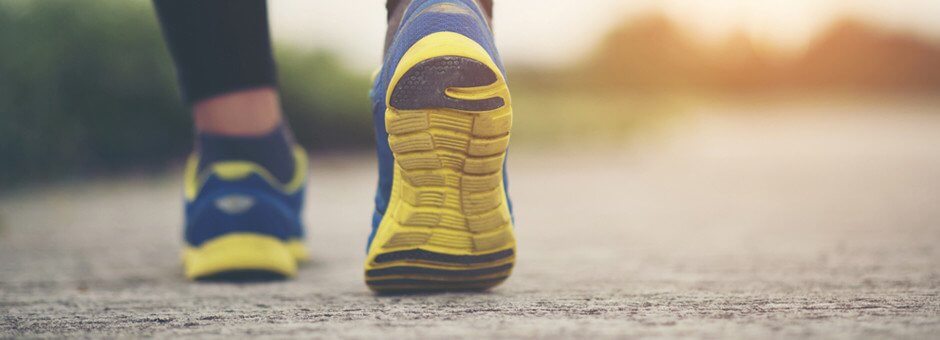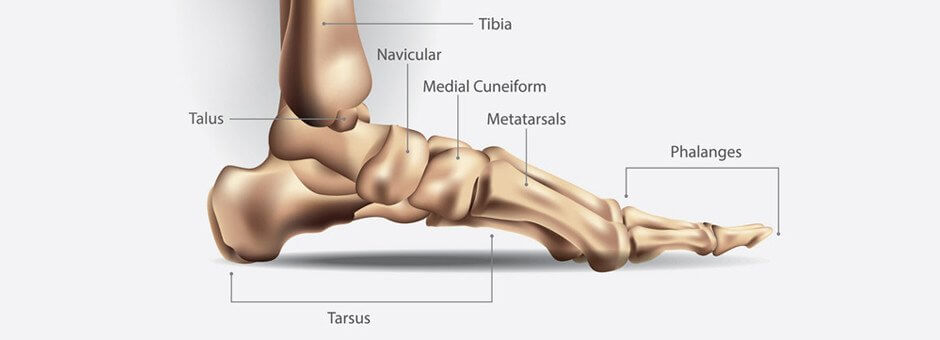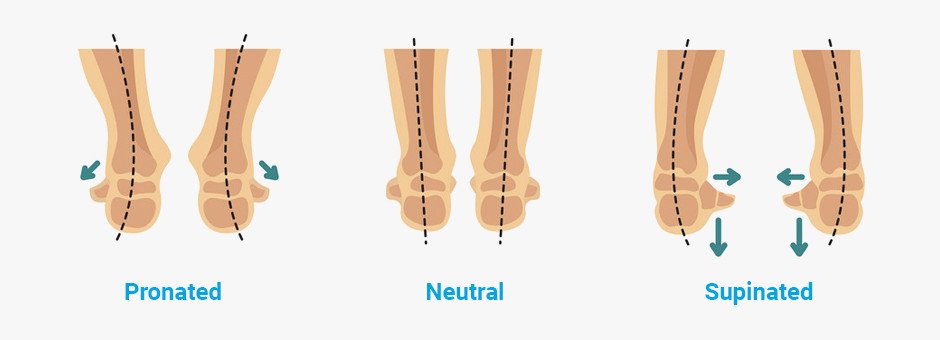
When the topic of foot pronation comes up, it seems that everyone is interested in which shoes they should buy. Perhaps they start with a discussion of running techniques and foot placement strategies, but soon they’re analyzing the wear of their shoe treads, wondering which shoe will increase or decrease their pronation, and entertaining the idea of minimalist shoes or even barefoot running.
The belief that pronation is determined entirely by one’s choice of shoe is a mistaken one. In fact, there’s a lot more to your feet than the shoes you wear. The mechanics of your foot are intimately affected by the entire body attached to it. I’d like to go over how your foot relates to your body as a whole, and exactly where footwear comes into the picture.
Before I begin, I’ll let you know in advance that I will not be recommending any brands. This post’s purpose is to give you an outline for how to think about footwear and pronation in general. The whole point is that it’s about more than the shoe.

To begin, let’s think about the relationship between the foot and the shoe. A shoe is what I call an external environment, and it follows that the foot can be called an internal environment. Problems of the foot arise when these two environments are out of sync with one another.
As you walk, the internal and external environments of your feet and shoes work in concert to move you along. If they are well matched, they work in harmony. They can also work counter to each other, creating an unpleasant movement experience and increasing your chances of injury.
Now, since the shoe is the medium through which the foot interacts with the world, it can control the foot’s movement to some degree. This is actually not desirable! Ideally, your foot should be controlling the shoe, not the other way around. That’s right, I’m saying that choosing a shoe to make your foot behave is the wrong approach.
As the foot is the primary instigator of motion, the responsibility for proper foot posture and movement begins with your foot itself, and not with the shoe you wear.

People are quite interested in what shoes do for pronation, but they rarely delve into how pronation relates to your foot itself, and what its purpose is.
Pronation is created and controlled by your feet, and no shoe in the world is going to fix poor pronation. I personally have never witnessed a shoe that permanently improved the wearer’s feet. In fact, a shoe can worsen an already undesirable gait, especially if nothing is done to address the fundamental issue of posture. When someone claims that wearing a barefoot shoe has fixed their pronation, the change is almost certainly because their posture as a whole changed, and not because of the shoe itself.
People are quite interested in what shoes do for pronation, but they rarely delve into how pronation relates to your foot itself, and what its purpose is. Pronation is created and controlled by your feet, and no shoe in the world is going to fix poor pronation. I personally have never witnessed a shoe that permanently improved the wearer’s feet. In fact, a shoe can worsen an already undesirable gait, especially if nothing is done to address the fundamental issue of posture. When someone claims that wearing a barefoot shoe has fixed their pronation, the change is almost certainly because their posture as a whole changed, and not because of the shoe itself.

Your foot’s ability to pronate and supinate is not something your shoe can truly improve, but it can certainly hinder the process. The reason is that the way you walk is much more powerful than anything you put on your foot. It affects your entire body as well.
Take a moment to think about the relationship of your foot with your shoe. What happens when you put on a shoe, how does your foot posture change? Does your foot pronate when you’re standing still, and does your shoe change this in any way? This is not something most people typically think about.
Every time you take a step, the pattern of your gait is neurally reinforced. Your steps naturally become consistent and predictable, and your entire body mirrors this pattern as well, with your shoulders and core moving just as predictably and reliably.
Walking is a repetitive motion, and repetitive motions are very hard to change. This is especially true given the flat nature of the modern pedestrian environment. When your foot is rarely challenged by variable terrain, your gait becomes more consistent over time. At the same time, a flat terrain also makes your gait less flexible and more difficult to alter. It takes quite a lot of awareness to get your feet out of their comfort zone.
A mere shoe can do nothing against the incredible power of habit. Shoes are simply fabric covering a shaped sole made out of foam or rubber, versus muscle and bone that drive movement. The shoe’s sole is actually similar in shape to a foot that overpronates, so it generally encourages pronation. It follows that if you tend to overpronate, most shoes will make the problem worse.
Even an anti-pronation shoe won’t help. The external environment of the shoe simply goes along with the motion of the internal environment, so a shoe with an arch will do nothing to prevent the inward roll of the foot. At best, the shoe may minimize pronation somewhat, but once it comes off, your foot will go right back to its old bad habits.
And how do barefoot shoes fare when it comes to your foot and pronation? Not as well as you’d think. I’ve seen many feet that appear to perfectly match the shape of the barefoot shoe they wear. My theory is that it’s not because wearers are choosing shoes with the same shape as their feet, but because the feet are conforming to the shoes over time. This signifies a weak foot that is unable to master its shoe.
I have also run across plenty of barefoot shoes that have the center of mass in the wrong place. When the center of mass of the foot and the center of mass of the shoe don’t line up, whichever is more mobile – usually the foot – will move toward the less mobile, most often the shoe. This means that a barefoot shoe may actually exacerbate pronation, or even cause worse problems if the mismatch is particularly egregious.
The takeaway from all of this is that, when buying shoes, we don’t really think about our feet. Instead, we think about the shoe’s appearance, how much support it has, and whether we’re wearing the recommended type of shoe for our activity. We’re thinking of our yoga routine, the marathon we’re training for, how much muscle we’re going to build, or how much fat we’re going to lose.
The last thing on our minds is the mobility of our foot and how the shoe will affect that. However, it is an important part of the entire exercise experience. It’s not as simple as choosing an anti- or pro-pronation shoe. You won’t find a shoe anywhere that teaches your foot to pronate properly. To do this, you need to address your general foot posture.
Think about your whole body and how it affects the movement of your feet. Think about the bones and joints down there, and how they move when you pronate and supinate. Research how you can attain maximum mobility for your foot, and work on developing the habit of a solid, healthy gait.
If you can strengthen the internal environment of your foot to make it equally facile at pronation and supination, then no shoe will be a match for it. You’ll be able to freely choose whichever shoes you like, and can prioritize comfort and color, rather than any misguided notions of how the shoe will improve your pronation.
First of all, a proper diagnosis must be established. Is it excessive rear foot or mid foot pronation? Is the cause of excessive pronation in the foot or in the hip? These details are hard to measure precisely, based on visual examination or palpation. The best way to measure and classify your foot behavior is with 3D gait analysis and pressure insoles, or a pressure instrumented treadmill. The best treatment really depends on diagnosis. No running shoes or custom orthotics can eliminate excessive pronation. You need physical therapy and gait retraining.
Working with a chiropractor and doing physical therapy exercises are the best ways to realign your body and correct your gait and overall movement. Now, corrective therapy is easier than ever, thanks to TeleHealth physical therapy and chiropractic services. Meet with your therapist online from your home, office or while traveling, and get the same great care and treatment as you would at NYDNRehab’s Manhattan clinic.
Dr. Lev Kalika is a world-recognized expert in musculoskeletal medicine. with 20+ years of clinical experience in diagnostic musculoskeletal ultrasonography, rehabilitative sports medicine and conservative orthopedics. In addition to operating his clinical practice in Manhattan, he regularly publishes peer-reviewed research on ultrasound-guided therapies and procedures. He serves as a peer reviewer for Springer Nature.
Dr. Kalika is an esteemed member of multiple professional organizations, including: